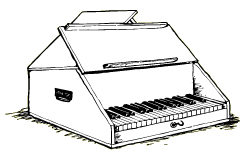Trivia
The keyboard glockenspiel: The celesta's closest relative
Changes to the glockenspiel
Today, when we say "glockenspiel" we are referring to a metallophone. These instruments are played by striking a row of tuned metal sound bars with mallets.
Actually, there used to be glockenspiels that were played with a keyboard. Other than their sound bars, modern glockenspiels have little in common with these older instruments. You might be surprised to learn that the keyboard glockenspiel was around even before the celesta was invented!
"Glocken" originally meant "bell" in German. If you travel to Europe and visit a church, you'll likely see a giant bell in it. Back in the 17th century, however, churches used an array of small bells turned to different pitches (covering roughly a three-octave range), that were lined up in order of height, hung from cords, and played with a keyboard. "Keyboard" is maybe not the best way to describe these contraptions, as the "keys" were like large buttons that were gripped in the hand and pushed. At any rate, in function it was basically a glockenspiel played with a keyboard.
As the design was improved the keyboard got smaller, giving us the keyboard glockenspiel.

An example of a keyboard glockenspiel
The glockenspiel and Mozart's "The Magic Flute"
Mozart's opera "The Magic Flute" tells the story of a man with a magic flute who, along with his follower (who has a magic bell), goes off to save a princess. Together they overcome many trials and grow united. A keyboard glockenspiel, representing the magic bell, is played at three separate times during the opera.
The instrument thought to have been used during the original performance is kept at the Vienna Museum. Interestingly, the sounding body is made of glass instead of metal, and the instrument itself is the size of a toy piano. It has a three-octave range. However, it is also said that the instrument used during the first performance consisted of a row of several round metal bars of varying lengths, so it's hard to say if the instrument at the museum is the real thing.
There's an interesting story behind this confusion. Mozart's "The Magic Flute" was such a massive success that opera houses all over Austria wanted keyboard glockenspiels so that they could perform the opera. However, other instrument makers did not have access to the instrument that was used during the first performance, so they ended up coming up with their own designs. These still exist today, so it is impossible to tell what the original instrument was really like.
Celestas and "The Magic Flute"
The celesta was invented in 1886, and Mozart died in 1791. Needless to say, Mozart didn't know anything about celestas. However, celestas are sometimes used when performing "The Magic Flute."
This is because there was a period of time where there simply were no keyboard glockenspiels available. Celestas however served as a fine substitute, since they too are keyboard instruments in which sound bars are struck with hammers. However, celestas differ from glockenspiels in that they provide a gentler sound, since their hammers are felt, not metal.
If you listen to recordings of "The Magic Flute" being conducted by Karajan or Bohm, you'll hear celestas being played. However, more and more concerts are using glockenspiels instead, in order to more closely reproduce Mozart's music as it was originally heard. These concerts make impressive use of the magic-like and gorgeous sound of instruments.
Pieces in which keyboard glockenspiels can be heard
Modern keyboard glockenspiels look exactly like celestas, except smaller. Mustel Company instruments have a range of 52C-92E (three and a half octaves). Unfortunately, these instruments are no longer being produced. They feature thick sound bars interconnected with metallic resonant tubes, which are struck by brass hammers attached to the keyboard.
Keyboard glockenspiels in orchestras are generally referred to as "jeu de timbres a clavier," which is a French term. Their timbre and gorgeous twinkling sound are put to wonderful use when playing orchestral music by Ravel or Debussy, but they are hardly ever used when playing Mozart's "The Magic Flute," possibly due to a preference for a certain timbre.
Some of the better-known pieces in which a jeu de timbres a clavier is played are listed below.
* In some cases, the conductor or player may use a celesta or standard glockenspiel instead.
- M. Ravel: "Daphnis et Chloe," "Ma Mere l'Oye," etc.
- C. Debussy: "La Mer"
- O. Messiaen: "La Turangalila-Symphonie"
- G. Mahler: "Symphonie 7"
- G. Puccini: "Turandot" (opera)
- T. Takemitsu: "Textures"
